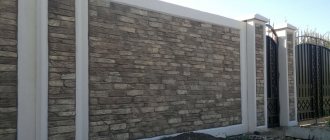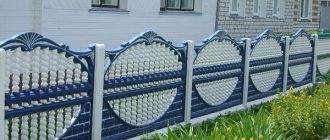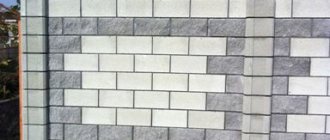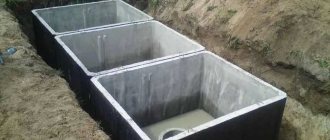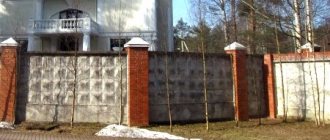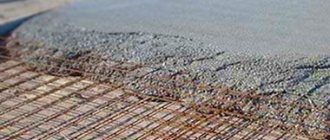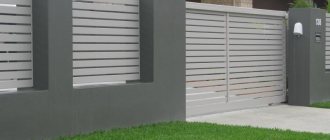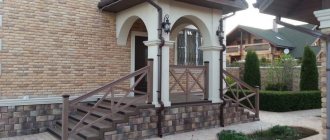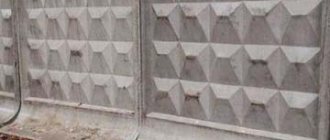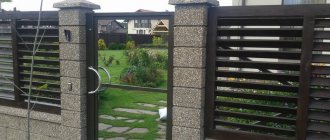A reinforced concrete fence has an attractive appearance and is a reliable fence.
Nowadays, many residents of large and noisy cities prefer to relax in country houses, where fresh air, harmony with nature and an atmosphere of tranquility allow them to escape from the hustle and bustle and everyday problems. And in order to feel comfortable at the dacha, you need to fence your plot with a reliable fence. And installing a concrete fence in this case is a worthy option.
Reinforced concrete fences are reliable, strong and durable. At the same time, they are very beautiful and easy to install, and the price of such structures will pleasantly please everyone who wants to save money. Due to the fact that this material has such high characteristics, the installation of reinforced concrete fences is of interest to many home craftsmen these days. This is what we will talk about in this article.
Panel characteristics
Advantages of concrete construction
The wide range of applications of reinforced concrete fences is due to a number of advantages compared to other types of fencing:
- convenience and ease of installation;
- reliability and durability of operation;
- no need for slab maintenance;
- fencing effectiveness.
Smooth concrete slabs
Basic properties
Panel concrete fences are characterized by:
- Reliable protective function of the territory or site;
- Additional protection of the area from wind and dust;
- Soundproofing function;
- Solidity and stability of the structure;
- Variety of panel textures. Fencing panels can be given a perfect smooth surface or a variety of designs;
- Possibility of manufacturing decorative reinforced concrete panels;
- A variety of fencing colors. Pigmented concrete is used in production, which makes it possible to produce sections of any color;
- Possibility to choose the height of the structure. The height of industrial fencing ranges from 2.5 to 4.0 meters, and for private use the height can start from half a meter.
Photos of textured sections
Types of structures
Concrete fence panels are manufactured:
- whole;
- prefabricated (assembled from two or more slabs);
- one-sided;
- double-sided.
Industrial concrete fence
According to the scope of use, reinforced concrete fence panels are:
- Decorative - for use mainly in the private sector. The price of such a fence will be lower than a stone or brick one. In addition, the area is additionally protected from dust and noise. In addition, they also perform an aesthetic function. Modern casting technology makes it possible to implement a variety of design solutions;
- Industrial - for fencing the territory of enterprises, organizations and institutions. The products are designed for use under heavy load conditions.
Decorative fence
Preparing to install poles for a concrete fence with your own hands (with video)
There are two main types of posts for installing a concrete fence: solid reinforced concrete posts with grooves and stacked “post stones”. Reinforced concrete pillars with grooves have the following groove sizes: 0.5 m; 1.0 m; 1.5 m; 2.0 m; 2.5 m, corresponding to the height of the fence. The lower part of the pillar without grooves is concreted into the ground and has a length of 0.8 m or 1.3 m.
Stacked pillars consisting of concrete elements have a height that is a multiple of the height of one panel - 0.5 m, while the total height of the fence can be more than 2.5 m. To install a fence with stacked pillars made of stones, a base (reinforcement, pipe) is required. which is concreted into the ground. Hollow stones are piled onto the base, then the inside of the stacked pillar is filled with concrete mortar. The top of the stacked post is covered with a concrete headband. Stones for pillars are made with 2 grooves, with 1 groove and without grooves (gate pillars). In corner posts, the grooves can be located at an angle of 90° relative to each other. The stacked elements of pillars can have either the texture of natural stone or a smooth surface.
Before making a concrete fence, you need to mark the installation locations of the posts at intervals equal to the length of the fence panel. The euro fence slab is exactly 2 m long, but due to the thickness of the post lintel and due to tolerances and gaps, the distance between the centers of the posts of each section is assumed to be 2.06 m. Most likely, the total length of a particular fence is unlikely to be an exact multiple of this distance, therefore Some slabs will have to be cut.
Before you build a concrete fence, plan in advance where the gate will be. If there is already a gate and it is metal, then it is best to vertically weld 30 x 30 mm corners to the support posts so that a 50 mm wide groove is formed for installing a concrete slab. Of course, you can dig concrete pillars next to the gate. This option is preferable when a new gate and wicket are simultaneously installed along with the European fence.
To install a concrete fence correctly, as professional builders advise, when planning you need to take into account that the Euro fence post has a cross-sectional size of 150 x 150 mm. This means that another 150 mm must be added to the total length of the sections due to the fact that the first and last pillars protrude to the sides from the center of the pit. For example, if you install 10 sections, the total length of the fence will not be 2.06 x 10 = 20.6 m, but 20.75 m.
Places for installing pillars for a concrete fence built by yourself are fixed with pegs, then a cord is pulled, marking the horizontal zero level.
The video “Do it yourself Eurofence” shows how the preparatory work is carried out:
The next section of the article is devoted to how to install pillars for a concrete fence.
Technological features of the installation
The concrete fencing structure can be fixed on special supports or installed separately. Free-standing fences are made not only of reinforced concrete slabs, but also of special glasses that serve as a base. The construction of a fence that involves the use of cups is not difficult at all: racks with panels are installed in the cup and filled with concrete.
If there is no need for permanent fencing, the posts can simply be secured with wooden wedges. The construction of a fence from reinforced concrete slabs cannot be called such a difficult task.
Diagram with dimensions for installing a concrete fence
Tools and materials
To install a fence made of reinforced concrete slabs, you will need the following materials and devices:
- Shovel and crowbar;
- Level and optical level;
- Wood slats;
- Cord or rope;
- Materials: crushed stone, cement, sand;
- Hard wire;
- Primer and facade paint;
- Concrete mixer (can be replaced with a construction mixer or drill with an appropriate attachment).
Article on the topic: How to melt soap in a steam bath
It is also necessary to invite one of your friends or relatives to help with the work.
Drawing of a pillar and concrete slab for installation
Preparatory work
Before you begin the main work, you need to thoroughly prepare for it. First of all, you should prepare and collect all the necessary tools and materials, check their functionality and the required quantity. First you need to determine the exact location of the future concrete fence.
To do this, using a tape measure, wooden stakes and a cord, the perimeter of the fence is outlined, and the locations for installing the posts are determined; all set aside distances must be carefully double-checked.
It is recommended to install supports every 2–2.5 meters, after driving wooden pegs into these places. You should also prepare in advance the holes in which the pillars will be installed if, during the construction of a concrete fence, a decision is made to abandon the construction of a foundation.
Pouring a monolithic foundation for the subsequent installation of a concrete fence
Installation of supports
In those places where you plan to install the fence yourself, you need to stretch the cord at a height of about half a meter from the surface of the ground. Thus, the perimeter of the future fence is clearly marked, and the resulting lines will not allow you to deviate in one direction or another during the work.
In the recesses prepared in advance for installing the pillars, it is necessary to arrange a special cushion consisting of crushed stone or gravel and sand. The cushion facilitates reliable installation of the supports in the hole and ensures the removal of moisture that enters during operation of the intake.
Next, you need to place the pillars on the gravel-sand cushion, establish their level position relative to each other using a level and securely fix them in the ground.
When installing pillars, they can be secured in the hole by adding stones, broken bricks, or waste concrete. The pit must be filled to approximately the middle of its depth.
A long strip corresponding to the length of the concrete slabs making up the fence wall should be placed in the groove of the support prepared in this way. This is done to control the correct placement of supports. You should also check that the supports “look” with their grooves towards the slats. To ensure that all supports are level, a hydraulic level should be placed on the rail.
If it seems that at any stage a mistake was made and the supports are unevenly located, then you will have to either deepen one of the holes where the post is located, or add soil into it, thereby reducing its depth.
It is necessary to fasten a wire or cord to the top of the concrete supports, and place an additional wooden strip in the grooves, which will allow you to more accurately maintain the required spacing between the supports.
Each support should be set strictly to the level, for which you will have to use the level again, and finally fix them in the holes. The wooden slats should not be removed yet; before laying the slabs, they should be placed with their ends in the grooves of adjacent supports.
Article on the topic: Which windows are better to install in a bathhouse
After all the supports are finally installed and secured, it is necessary to prepare a cement-sand mortar of a creamy consistency based on a ratio of 1 to 4. After which you need to check again whether the entire fence structure is installed evenly and fill the remaining part of the holes in which the supports are installed with the solution .
After filling all the holes, you should check the position of all the pillars for the last time using a hydraulic level, since during the process of filling the holes with the solution, a deviation in the position of the pillars under the influence of the weight of the solution can occur that is quite noticeable even to the naked eye. All inaccuracies and errors, even very small ones, should be eliminated immediately, without waiting for the solution to harden.
Installation of supports on the foundation
If, when building a concrete fence with your own hands, you decide to install it on a strip foundation, then some changes must be made to the installation technology. When digging holes for supports, it is necessary to make a trench for the foundation in parallel. The depth of the trench should be the same as for pits, but the width should be slightly less.
After preparing the trench, you need to build wooden formwork of the required size. In order to save effort and time, as well as slightly reduce the final cost of the fence, it is recommended to make the formwork for one span, and then transfer it to the next work site.
A sand and gravel cushion is placed at the bottom of the trench, reinforcement is installed and the body of the future foundation is filled with a solution of the same proportion and consistency that was adopted for filling the holes.
Preparing pillars for pouring the foundation
Installation of reinforced concrete panels
Once the installation of the pillar supports is completed and they are securely fastened in the holes with mortar, you can proceed to installing reinforced concrete panels with your own hands. If the work is carried out in the summer, then installation can begin the next day after installing the columns. In spring and autumn you should wait a few days.
Article on the topic: Which fence is considered permanent
Installation of the slabs is simple: they are inserted from top to bottom into the spans, sliding along special grooves in the supports. During this work, it is necessary to carefully monitor the uniform filling of empty spans. When performing this work, there is no way to do without an assistant, and if the wall panels are too heavy, then a truck crane may be required.
Tips and tricks
If it is necessary to give the fence a suitable color, then the surface of the panels and posts must be primed and painted with facade paint. Also, even before installing the fence, you can purchase panels that are made of pigmented concrete, produced in various colors.
To protect the fence from bad weather, it is recommended to install protective caps made of metal or concrete on top. You can decorate the foundation or columns with your own hands with various decorative elements, which, however, will lead to increased costs and will slightly increase the cost of constructing the fence structure.
Decorative blocks for fence
A decorative concrete fence can be assembled from blocks. Such structures do not always require a foundation; massive supporting pillars are also not needed. To make blocks, a concrete mixture with fillers in the form of crushed stone, waste slag, expanded clay, broken brick, glass or very fine gravel is used. According to their block type there are:
- solid without voids, rarely used for fencing,
- hollow with a smooth or factored surface, can have dimensions of 390*140*188 mm.
In appearance, such a fence resembles a brick one, but in terms of its qualities it is more durable, reliable, and can have a richer design.
Manufacturers of concrete slabs for fencing
Among the well-known domestic companies are the following:
- "Concrete Trade" The company produces one-sided and double-sided concrete fences. All products are certified. produced in accordance with European technologies.
- "Decor Fence". The company manufactures sections and components for concrete fences. Works with wholesale and retail customers.
- "BST Profit" Produces one- and two-sided prefabricated concrete fences. A wide selection of colors, shapes, and textures are available. Custom orders for production are accepted.
- "ProfStroyZabor" Engaged in the production of concrete sections of various shapes and designs. The quality of the products is confirmed by a guarantee and certificates.
In most companies you can not only buy the design you like, but also agree on delivery and turnkey installation.
Special coatings
Everyone knows that metal products are not friendly with excess moisture. It leads to the formation of rust. To extend the service life of the fence and protect it from various negative factors, various compositions and solutions are used.
Experts assure that in the area of welded joints the metal is subject to intense corrosion. This is due to carbon loss. To prevent unpleasant consequences, various processing technologies are used.
There are several methods for coating a product with a special composition:
- Powder coating.
- Galvanic method.
- Application of polymers.
Installation of a self-contained concrete fence without a foundation
Since a self-standing reinforced concrete fence is a construction object that can be dismantled over time and moved to a new location, in some cases a method of installing it without a foundation base is suitable. The procedure itself goes as follows:
- Digging a trench in the entire pre-marked area. The depth will be 10-15 cm, the width will be 20-25 cm greater than the base of the slabs.
- Organize a cushion from a standard mixture of sand and gravel or crushed stone with repeated periodic compaction.
- Laying out slabs using a construction crane.
For this purpose, concrete cups for fencing act as supporting components, which are responsible for keeping the slabs in the required position after being fixed on special spikes. The procedure includes the following steps:
- Marking the area for future fencing by pulling a construction thread.
- Placing glasses at the required distances, which correspond to the possibilities for further fixing the slabs.
- Installation of slabs inside the grooves of previously installed glasses.
Installation technology
The design of a reinforced concrete fence includes a section of fencing slabs installed on a foundation element (cups). The section is inserted into the groove of the glass, the mass of which is about 500 kg. Each slab rests on 2 glasses and such a fence does not require a solid foundation. The installation of a reinforced concrete fence takes place using special construction equipment on previously prepared, reliable soil.
The installation technology is as follows:
- installation of the foundation glass on dense soil,
- inserting supports (fence posts) with grooves into the hole of the glass,
- Having concreted the pillars tightly into the grooves, the installation of reinforced concrete products follows.
Recently, monolithic concrete fences have also gained popularity. The technology for installing such a fence consists of using supports that replace pillars and then pouring them with concrete. After drying, the fence is completely ready. This type of installation is more popular among private lands and country houses, as it contributes to the decoration.
Another type of structure, widely used for fencing commercial and industrial enterprises, is a self-standing concrete fence, the installation of modules of which does not require much time and expense. This type of block is a continuous support structure with no sectional features and does not require concrete pillars or plinth panels for installation.
In addition to fencing functions, reinforced concrete fences are also popular as decoration and can be made to suit a wide variety of construction designs.
A large professional company can always present a catalog in which a large selection of common reinforced concrete blocks: prefabricated concrete fences, colored concrete fences (manufactured using glossy paint), SKALA type concrete fence, modular fences, etc.
Decorative reinforced concrete fences are popular for commercial organizations, summer cottages and private households. The appearance of fence blocks from each block model can be seen more clearly in the video.
Why do you need to paint a concrete fence?
Concrete is a durable material, but due to its porous structure it is susceptible to external influences and natural phenomena.
During precipitation, moisture penetrates and accumulates in the depths of the structure. Low temperatures change the physical properties of water - they expand the volume. Periodic freezing and thawing significantly reduces the strength of concrete.
Places where liquid accumulates are a favorite habitat for mold spores and spore-bearing plants - mosses, lichens, fungi. Actively multiplying, unsightly spots disfigure the appearance of the fence.
Without a protective coating, a concrete fence loses its appearance and foundation strengthSource fizzano.com
The proximity of industrial enterprises and highways has a detrimental effect on the fence. Aggressive toxic elements released into the atmosphere trigger destructive processes, even in stone.
All this leads to the formation of cracks and chips on the untreated surface. Painting the concrete fence will prevent disastrous consequences. In addition, a correctly selected color scheme will harmoniously fit the design into the overall style of the house building and the plot.
The psychological aspect is important. By surrounding oneself with gray color, a person at a subconscious level is deprived of bright positive emotions. Adding color to everyday life is an extra chance to get away from depression. After all, the visual perception of light turns into tactile sensations.
Means for cleaning concrete from mold and spore plantsSource lingot.kiev.ua
Description and types of products
Thanks to modern technologies, concrete fences are available in various variations. If earlier such fences looked gray and boring, now they are a real decorative decoration of the site. Currently, there are five types of concrete fences.
A sectional concrete fence will provide excellent protection for your property.
These include:
- block;
- typesetting;
- monolithic;
- monolithic self-standing;
- decorative (Euro fences).
Each of these types is divided into separate subtypes, since everything depends on the installation location of the fence, design and production method.
Block-type fences are erected from hollow or monolithic blocks. The advantage of this design is that it absolutely does not require the installation of intersection poles. The downside is that such a fence requires special finishing. For example, in decorative plastering or facing with textured tiles.
Most often, a set consists of four pieces. In this case, the lower slabs are made blank, and the upper ones - in the form of a through ornament.
In this video we will look at installing a concrete fence:
The monolithic type of fence structures is considered the most durable. Its distinctive feature is its rather heavy weight, which directly complicates the installation process. For monolithic sections, a columnar or strip foundation is required, which other types can do without.
Self-standing monolithic fences are installed without a foundation. They owe this to their wide base, which allows them to be in an upright position.
Eurofences are concrete fences that combine high quality and external beauty. Recently, they have become very popular among owners of suburban areas due to the wide selection of shapes, textures and colors. For example, you can put a fence on the site made to look like natural stone or brickwork. In addition, there are combined types on sale, decorated with stone or forging.
Eurofences are divided into two types:
- one-sided;
- bilateral.
https://youtube.com/watch?v=geA-CJOQDxc
Decor options for the fence
Concrete differs from many fences in that it allows for a wide range of different kinds of design manipulations, some of which we will consider right now:
- Painting is the simplest and most cost-effective option, which uses acrylic, polyurethane, rubber base, and so on. At the manufacturer's factory, you can choose the color of the canvas, which will speed up the painting and installation of the concrete fence.
- Plaster is used for block types of fencing, where it is intended to hide the joints of bricks.
- The same applies to finishing with mosaics, decorative stones and panels. Options for cast and block structures.
Article on the topic: How to decorate the walls in a washroom in a bathhouse
What brand of concrete is best to use for a fence?
A fence around your own plot of land or any other object will allow you to fence off the territory from unplanned intrusions. Additionally, such a design aims to hide the space from prying eyes
It is important to choose which brand of concrete is best to use for the fence
. The most common type of foundation is strip and pile options. This depends on the total mass of the ground part.
If the fence elements do not have significant weight, a pile type of structure is used. It is distinguished by its simplicity and affordable cost. Brand of concrete for the fence
varies between M100-M200. There is no need for a high quality mixture, since its main purpose is to hold the pile in an upright position.
The strip foundation must ensure reliability for the entire structure. For this purpose, the grade of concrete for the fence
should be slightly higher than that of the pile version. As a rule, material M150-M250 is used. It has the strength and resistance to adverse factors required in this area.
If you need to choose a brand of concrete for a fence
not for a foundation, but for monolithic slabs, a product of significant quality is required. Additionally, reinforcing elements are used as part of the structure. Thus, the M250-350 brand is optimal.
What to look for when choosing a fence
If you decide to isolate yourself from the outside world with a reinforced concrete fence, when choosing sections, pay attention to the following points:
- brand of concrete. Optimally, M200 or M300 is used. There is no need for a higher one;
- compare prices for the same model from different sellers and manufacturers. Too low a cost may indicate non-compliance with the technology;
- There should be no cracks, scratches, chips or pores on the surface. Defects that seem minor at first glance may indicate accelerated drying or a large amount of sand;
- No reinforcement should be exposed to the surface. Under the influence of atmospheric moisture, the metal will sooner or later begin to rust and the structure will collapse;
- If possible, find out how many layers of reinforcing mesh are laid. The more there are, the better, provided the previous point is met;
- On an unpainted product, take a closer look at the shade. Predominance of blue is preferable, but not faded gray.
Preparatory work
The first stage of the work is marking the territory:
- If a strip foundation is used, you should use a rope and pegs to mark the boundary of the site and determine the location of the supports. With this width, the future ditch should be equal to the width of the section or blocks plus an additional 40 cm for reserve.
- The depth of the trench should be from 60 cm, with high soil moisture - from 80 cm. To correctly determine the depth, it is necessary to take into account the characteristics of the region and soil, the freezing point, and the occurrence of ground moisture.
Most often, a strip foundation is used for a concrete fence; for this, a layer of sand and crushed stone is poured onto the bottom of the trench, and waterproofing in the form of a sheet of roofing material is used for the walls. The next step is to install support pillars, formwork, and pour concrete.
sand cushion
Laying the foundation
Waterproofing scheme
When pouring the foundation, it is recommended to use a reinforcing belt, which provides the necessary strength of the foundation and the ability to withstand the weight of the fence.
Varieties
There are 2 main groups of concrete fencing: for the industrial sector and for private areas. Concrete fences are produced in several types.
- Monolithic. Massive non-lifting structures can only be installed using lifting equipment and with the obligatory pouring of a foundation (column or strip).
- Typesetting. Sections that are made up of 3-4 parts of reinforced concrete slabs, fastened to one another, where the lower tier consists of a blind element, and the upper one is made in a carved or any other form. This fence can be installed without a foundation.
- Self-sufficient. They are made up of concrete monolithic sections with a wide cast base (sole). Installation of self-standing fencing does not require any foundation.
- On glasses. These are fences made of reinforced concrete slabs, which are mounted on blocks that are equipped with special holes or slots for laying sections.
The marking of concrete structures is deciphered as follows:
- PO (fence slab);
- FO (fence foundation);
- EO (fencing element).
Typically, PO-2 type structures are chosen for fencing areas. This is a solid slab of concrete, rectangular in shape, 3 m high, 2.5 m long, 15 cm thick and weighing about 1.5 tons. Such structures are used for fencing industrial facilities, construction sites, military units, warehouses and other strictly protected areas and objects.
Self-sufficient
consists of structures that combine a panel and a support base.
A structure of this type is most often installed without leveling and compacting the soil and building a foundation.
They are mainly used for fencing construction sites and industrial sites.
Positive sides:
- Leveling the soil takes little or no time at all.
- There is no need for a foundation, since the support is a continuation and base of the slab.
- The fence is removable and, if the need arises, can be moved to a new location.
- During installation, manual labor is practically not used; installation and dismantling is carried out using machinery.
- Ideal for places with close groundwater, where pouring the foundation requires reinforced reinforcement and deep installation of the foundation.
- Quick installation and dismantling, which allows, if necessary, to dismantle the fence and move it to a new location.
- Savings on consumables needed to connect slabs into a single structure.
- Durability and reliability. Made of very durable material that is difficult to damage or topple without special equipment.
Negative sides:
- You cannot install a fence made of slabs on the soles on slopes and hills, but only on a flat area.
- Due to the heavy weight of the slabs, self-standing structures can only be installed using heavy equipment.
Plates on glasses
consists of two types of reinforced concrete structures:
- glass support made in the shape of a pyramid;
- panel.
Fences on glasses are used for fencing both areas of industrial zones and personal territories. This fence is cast from strong concrete.
Positive sides:
- The design is practical, not subject to the action of groundwater and weather conditions.
- Work can be carried out at any time of the year at temperatures not lower than minus 5°.
- Over the years, the fence does not lose its attractiveness, since it is not affected by weather conditions.
- Additional care (painting, whitewashing) is not necessary.
Negative sides:
- A foundation is definitely needed.
- The choice of concrete slabs is made depending on the terrain.
Reliability criteria for a contractor company
You need to know that the technology for manufacturing reinforced concrete slabs, unlike installation, is quite complex. When ordering a reinforced concrete fence, the client can count on the high quality of the future fence if:
- In the production of concrete blocks, only special high-class concrete is used, which is characterized by increased strength and resistance to climatic conditions. Thanks to high-quality raw materials and correct production techniques, an installed fence made of concrete sections will last a long time and will be able to withstand a significant level of external influence.
- Installation of the concrete fence occurs in compliance with the necessary technical requirements. A professional approach to installation contributes to the long-term stability of the fence.
- Upon completion of installation work, the customer receives a completely finished concrete fence that does not require additional processing.
Based on this, the company must have its own production plant, a staff of qualified engineers and foremen, and also be a legal entity. It must be remembered that the quality of the future fence directly depends on the company’s capabilities, and therefore, the more capacity it has and the more serious its staff, the higher the guarantee of obtaining high quality.
How to make a fence more attractive
Standard concrete blocks are not the most aesthetically pleasing option. If you believe that your site deserves better design, build supports from special building hollow blocks. Advantages of this option:
- a wide variety of shapes, finials, imitations of natural materials;
- an electrical cable is placed in the cavity in compliance with safety regulations and in the presence of waterproofing;
- less weight per block than a standard support.
After laying all the blocks and installing the electrical wiring, the cavities are filled with concrete made from M500 cement to increase the strength of the entire structure. Supports of this type will support not only intermediate sections, but also forged gates and additional design elements.
Construction of a fence
It prevents a vacuum from forming between the surface of fresh concrete and the wall of the form. Before the vibration starts, the holes are closed, and after it is completed they are opened. The simplicity of the technology and the availability of working equipment suggest the possibility of independent production of a Eurofence.
The answer to this is ambiguous and depends on the number of slabs and pillars you need. If we are talking about several dozen structural elements, then it is better to purchase them from the manufacturer. If fencing a site requires several hundred posts and sections, then it makes sense to buy equipment, forms for a European fence and do it all yourself.
The video shows an example of unacceptable savings on reinforcement when, instead of mesh, individual pieces of wire are placed in concrete.
Advantages and disadvantages of a self-supporting reinforced concrete fence
Precast concrete fencing has a number of undeniable advantages due to the material used and the properties of the final structure. Therefore these include:
- high strength and wear resistance;
- withstand heavy loads and various types of mechanical impacts;
- fire and frost resistance;
- service life;
- ease of installation and operation;
- high degree of reliability.
A self-contained concrete fence has a number of additional advantages compared to other fencing options made of concrete:
- the final product has a single name and complete assembly, that is, it simply does not require any packaging;
- small time costs for the installation process due to the reduced number of operations for lifting and lowering elements;
- low cash costs due to a small number of consumable components, which results in connecting the slabs into one wall.
- the presence of a T-shape allows for easy installation and dismantling processes for the purpose of placement in new locations.
A self-standing reinforced concrete fence has a significant drawback, which is the inability to implement slopes on the products. That is, their installation can be done exclusively on horizontal planes. Therefore, they exclude the presence of complex terrain.
What grade of concrete is needed for the foundation of a house, depending on the load?
- Concrete M200 for a building whose walls are made of rounded logs, timber, foam blocks, cinder blocks, wood concrete, gas silicate or expanded clay concrete blocks;
- Concrete M250 for brick buildings with concrete floors;
- Concrete M300 for two or three-story buildings with concrete floors.
It should be noted that the specified grades of concrete are given in the “not lower” format. This means that if the concrete grade M200 is recommended for the construction of a strip foundation, it is allowed to build a structure from grades M200, M300, etc. It’s just that the M200 brand is the most optimal in terms of the cost of the foundation and its ability to perform the functions assigned to it.
Types and characteristics of fence slabs
Elements of reinforced concrete structures intended for fencing are manufactured in a standard sample with various design options. Depending on the manufacturing method and shapes, monolithic blocks are distinguished, which have a long service life. Hollow products are low cost and cables can be easily installed in them.
These slabs are used for the installation of prefabricated fences. Cement mortar is used to fasten the elements. A strip foundation is poured under the structure. The finished fence requires additional finishing with plaster, tiles, and artificial stone.
According to their design, there are typeset fencing, in which a section is formed from 3-4 elements. This option involves the use of separate panels that are installed on top of each other.
Solid analogues are built from monolithic sections. Precast concrete fence slabs are in high demand, the dimensions of which are (height, length, thickness), cm:
- 200x300x12, weight - 1300 kg;
- 200x400x16, weight - 1700 kg.
Products are marked and manufactured in compliance with GOST requirements. For example, the standard size of the P-6VA slab is:
- length - 3980 mm;
- thickness - 160 mm;
- height - 2200 mm;
- volume - 0.64 m³.
When installing fences, AF-1 stands and S-3B grade posts are used. The main components of the slabs are concrete grade M20, reinforcement class A-3, BP-1. Depending on the parameters, the weight of the slabs is 1500-300 kg. When marking products, the type, dimensions, standard corresponding to GOST and technical conditions are indicated.
Europanels
The basis of the structure is concrete sections, which are produced by artistic casting. Eurofence - fences that have patterns and textured fragments. The products differ in configuration, are available in a range of colors, and do not require painting.
Based on the type of decoration, a 1-sided fence is distinguished, which is decorated on the front side. Decorative sections with 2-sided relief are distinguished by the thickness of the structure and high price. Europanels are combined with forged elements, carved wooden fragments, gates and gates made of corrugated sheets.
Block panels
Unlike panel fences, block structures are mounted on a concrete parapet. This type of fencing is assembled from small blocks. In the production of structural elements, concrete with the addition of pigments is used.
Such reinforced concrete fencing can easily withstand dynamic loads. During installation, no support pillars are required, and when complete, the fence looks like high-quality brickwork. Installation requires minimal labor costs.
The voids inside the elements help strengthen the structure before it is filled with concrete. Fences are installed on a foundation, the thickness of which should exceed the width of the blocks by 2 times.
The height of the fence is selected taking into account the wishes of the customer. The blocks are distinguished by a stylish two-sided texture; their use allows you to build a fence that matches the exterior of the house. The advantage of this type of fencing is the ability to create a base or pillars from existing elements (for example, antique-style columns).
Tile products
Decorative fences made of slabs are installed near any structure, private home, enterprise, warehouse. Concrete panels can have patterns in the form of torn stone, oval, brickwork, waves. The main height of the fence is 0.5-2.5 m. Through the use of additional segments, it is increased to 4 m.
Fence slabs are manufactured using vibration casting. To do this, concrete mixture is poured into fiberglass molds and compaction is performed on a special table. After cement laitance appears on the surface, a reinforced mesh is installed, which is placed at a distance of 1.5 cm from the edges of the form.
The slabs dry for 12-48 hours, after which they are removed from the mold and placed on a rack for final drying, periodically moistening with water. The technology for producing plates in factories involves additional steaming in special chambers for 7 hours.
Production
Concrete panels of this type are produced by vibration casting. The concrete mixture is poured into special molds placed on a vibrating table. After undergoing certain processing, the mixture becomes denser. Each such form differs in its configuration and design.
Panels are made with different external surfaces. She may be:
- Imitation of a brick wall;
- Marble;
- Natural stone;
- Mosaic;
- Matt;
- Glyantseva.
Today there are stacked fences framed with an iron frame. In this case, concrete is combined with a variety of materials:
- Picket fence;
- Grid;
- Forged parts.
Original concrete fence with forged elements
Varieties
There are 2 main groups of concrete fencing: for the industrial sector and for private areas. Concrete fences are produced in several types.
- Monolithic. Massive non-lifting structures can only be installed using lifting equipment and with the obligatory pouring of a foundation (column or strip).
- Typesetting. Sections that are made up of 3-4 parts of reinforced concrete slabs, fastened to one another, where the lower tier consists of a blind element, and the upper one is made in a carved or any other form. This fence can be installed without a foundation.
- Self-sufficient. They are made up of concrete monolithic sections with a wide cast base (sole). Installation of self-standing fencing does not require any foundation.
- On glasses. These are fences made of reinforced concrete slabs, which are mounted on blocks that are equipped with special holes or slots for laying sections.
The marking of concrete structures is deciphered as follows:
- PO (fence slab);
- FO (fence foundation);
- EO (fencing element).
Typically, PO-2 type structures are chosen for fencing areas. This is a solid slab of concrete, rectangular in shape, 3 m high, 2.5 m long, 15 cm thick and weighing about 1.5 tons. Such structures are used for fencing industrial facilities, construction sites, military units, warehouses and other strictly protected areas and objects.
Self-sufficient
A self-standing fence is made up of structures that combine a panel and a support base (foundation), which simplifies the installation of the fence.
A structure of this type is most often installed without leveling and compacting the soil and building a foundation.
They are mainly used for fencing construction sites and industrial sites.
Positive sides:
- Leveling the soil takes little or no time at all.
- There is no need for a foundation, since the support is a continuation and base of the slab.
- The fence is removable and, if the need arises, can be moved to a new location.
- During installation, manual labor is practically not used; installation and dismantling is carried out using machinery.
- Ideal for places with close groundwater, where pouring the foundation requires reinforced reinforcement and deep installation of the foundation.
- Quick installation and dismantling, which allows, if necessary, to dismantle the fence and move it to a new location.
- Savings on consumables needed to connect slabs into a single structure.
- Durability and reliability. Made of very durable material that is difficult to damage or topple without special equipment.
Negative sides:
- You cannot install a fence made of slabs on the soles on slopes and hills, but only on a flat area.
- Due to the heavy weight of the slabs, self-standing structures can only be installed using heavy equipment.
Plates on glasses
The set of this type of fencing consists of two types of reinforced concrete structures:
- glass support made in the shape of a pyramid;
- panel.
Fences on glasses are used for fencing both areas of industrial zones and personal territories. This fence is cast from strong concrete.
Positive sides:
- The design is practical, not subject to the action of groundwater and weather conditions.
- Work can be carried out at any time of the year at temperatures not lower than minus 5°.
- Over the years, the fence does not lose its attractiveness, since it is not affected by weather conditions.
- Additional care (painting, whitewashing) is not necessary.
Negative sides:
- A foundation is definitely needed.
- The choice of concrete slabs is made depending on the terrain.
About reinforced concrete
Reinforced concrete is a durable building material that was originally used in the construction of buildings. Nowadays, reinforced concrete fences are very popular, which are used both for fencing private property and protected objects, for example, construction sites, factories or parking lots.
And if in the first case we are talking about decorative fences, then for protected objects they use massive slabs, which are simply impossible to install or dismantle without the use of special equipment.
Self-standing concrete fence.
The structure of a reinforced concrete slab is very simple. It consists of a metal frame cast into durable concrete. The frame holds the concrete base from destruction, giving the structure durability and resistance to environmental conditions.
Installation features
Installing a fence made of concrete slabs is a simple process that you can probably master with your own hands. The only thing is that to install the sections themselves, it would be advisable for you to involve one or two assistants, since the weight of a standard section of a stacked fence reaches 70 kg.
If we talk about self-standing slabs, then the weight of one element can reach 2 tons, and to install a reinforced concrete fence you will need a crane. But such options are very rarely considered when constructing fences for private houses, since they have an unattractive appearance.
We will consider the installation of a decorative or stacked reinforced concrete fence, each section of which consists of 3-5 horizontal slabs that are stacked on top of each other (collected), fixed in special grooves of the pillars.
Schematic instructions for installing inlaid fencing.
Decorative fences made of reinforced concrete have standard panels, the dimensions of which are 50 by 200 cm.
The installation features of sections from different manufacturers are the same; significant design differences are present only in the installation of poles, which come in two types:
- Whole.
- Prefabricated.
Installation of prefabricated structures is more labor-intensive, so first we will consider a simpler option with solid supports.
In order to correctly install such a structure, there are simple instructions:
Solid supports
- The installation of a reinforced concrete fence begins with the preparatory stage, that is, marking the territory. Among other things, this will allow you to determine the required amount of materials.
Advice! For ease of marking, cut a two-meter block from wood, measuring the distance with it. Remember that measurements should be taken exactly in the groove. Otherwise, the section may not fit between the supports or may not be supported by them and fall out.
- Start installing a concrete panel fence with a corner post.
Dig a hole in the designated location. It is recommended that the pole goes into the ground at least a third. That is, the supports of a two-meter fence should go into the ground to a depth of 1 meter. For a standard hedge, as a rule, 70 cm in depth is enough.
- Level the support and secure it with wooden spacers.
- Concrete the pillar as in the photo above.
- Perform all the above operations with the second pillar.
- Now we move on to the installation of the section. Considering its weight, you should consider getting a helper. Installation of the element is very simple - you just need to install it in the grooves of the installed supports.
Advice! Do not install more than two sections between two posts at once. Build the fence gradually, this will prevent the structure from skewing.
- Having reached the corner, you should mount two supports closely, perpendicular to each other.
- Repeat the steps above to complete the fence design.
Installation of concrete sections.
Prefabricated supports
The instructions for installing fencing on prefabricated supports are somewhat different from the previous one and provide for the following steps:
- Installation of concrete fences in this case involves the construction of a base for a pillar. To do this, you should dig a hole 50cm deep, which should be 50mm wider than the post block on each side.
- Install reinforcement in the hole, diameter 10-12, the length of the fence + its underground part.
- Level the reinforcement and concrete the hole.
- Place the first section of the post on the base, concrete the free space.
- Mount the next element, thus building a support.
Advice! Concrete each section of the post separately, so the solution will spread throughout the entire support cavity.
- Assemble the second support in the same way.
- Next, the sections are installed, which does not differ from the method described above.
Installation of sections on prefabricated poles.
Advice! Upon completion of work, a concrete cover should be installed on the pole. It will protect it from leaching of the solution, extending the service life of the support, and therefore the entire fence.
How to install
To construct a fence, it is advisable to make a project. This will help calculate the load and determine the dimensions of the fence and the required amount of materials. If you have a project, you can begin marking the site.
Most often, owners choose reinforced concrete fences consisting of separate sections. In this case, buy slabs and pillars. To carry out installation work, you will need a concrete solution, which is prepared on the basis of cement, crushed stone and sand.
After marking, you need to drill holes for the pillars in pre-designated places. Most often they have parameters of 30x30x50 cm. The pitch between the pillars depends on the size of the panel. Drilling holes for them is carried out using a hand drill. The bottom of such a hole is certainly compacted. Then a layer of sand is poured there.
Some experts believe that it is also necessary to insulate the walls of the drilled hole with roofing material in order to provide reinforced concrete structures with protection from high humidity.
Experienced craftsmen recommend that the installation of pillars be carried out with the efforts of at least 2 people, rigidly fixing such structures in the holes, without using a concrete mixture at this stage. But it is impossible to do without using the latter entirely; this option is used only in cases where light wire mesh is attached to the posts. Each pillar has recesses into which the slabs must be inserted.
Only after that the pillars are concreted. When the solution is poured into the hole, you need to ensure that the rolled roofing material placed there earlier is carefully straightened out, pressing against the walls. The concrete mixture must be bayoneted with a wooden strip. Then there will be no air bubbles left in it, which could reduce the strength of the structure.
After installation work is completed, many owners coat sections of the fence with decorative paint so that it fits better into the landscape design.
Sometimes installing a fence requires building a foundation. The choice of its type depends on the characteristics of the soil in a given area. For example, a strip foundation is considered a suitable choice for swampy areas where the soil contains a lot of moisture. Columnar bases are used for heaving soils. The order of work here will be exactly the same - first the project is done, the site is marked, then the foundation is constructed, pillars and individual panels are installed. But more often a monolithic fence is installed on the foundation.
The construction of a strip base requires the use of formwork. It must be installed level, since this is the only way to ensure the strength of the foundation.
The installation of a columnar base requires the preparation of holes for the pillars. But unlike the method described above, the depth of the pits should be greater - up to 1 m. Additional supports are often attached inside such pits.
Assembly of the entire structure
The finished panels are placed in the grooves of the pillars or the reinforcement of each panel and pillars, previously brought to the surface, is welded together. At this stage, the installation work on installing the reinforced concrete fence can be considered complete.
The finished structure is additionally finished with decorative materials - plaster, facade paint for concrete, tiles. Be sure to paint all welded parts with weather-resistant paint to prevent corrosion. Fences made in this way retain all the advantages of a concrete fence. They do not absorb moisture, have low windage, excellent sound insulation, and are extremely durable. A solid concrete fence in rural areas can become a reliable barrier to ground fire during spring grass burning, which leads to huge fires and human casualties.
vote
Article rating
Decor and painting
Most often, concrete fences are designed to resemble the relief of natural stone. Imitations of branches of various trees, solid masonry of stone and brick, logs or timber are also popular. More complex designs may consist of several types of blocks. They are often impossible to distinguish from options that are made of natural stone. At the top of the fence, an imitation of a lattice or baluster is most often made. With the right choice of color and decorative texture, it is almost impossible to determine what exactly the fence itself was made of.
Concrete is an amazing coating
With its help, you can realize any fantasy idea, which is especially important in cases where the usual appearance of the product seems gray and boring. It is not at all necessary that this design perform only a protective role. Many hedges are truly colorful pieces
If you purchased (or made yourself) panels with beautiful protrusions, reliefs, patterns or weaving, then all you have to do is take good care of the coatings: clean them on time, tint them if necessary. If your new fence is not yet painted, you can decorate it yourself in a matter of hours. Its appearance is determined by the owner of the home
Many hedges are truly colorful pieces. If you purchased (or made yourself) panels with beautiful protrusions, reliefs, patterns or weaving, then all you have to do is take good care of the coatings: clean them on time, tint them if necessary. If your new fence is not yet painted, you can decorate it yourself in a matter of hours. Its appearance is determined by the owner of the home.
When decorating a structure, you can use the following options:
- coloring;
- combination with forged components;
- laying stylish tiles, stone or special panels that imitate different materials;
- the use of artistic exhibition, original graffiti, drawings with popular cartoon characters;
- imitation of plants such as climbing ivy, rose and many others.
If you need to choose a paint color for a fence, then the most preferable colors from the point of view of the surrounding space are green, gray, brown, blue or dark beige. These natural tones will go well with the greenery around the fence. You shouldn’t decorate the fence too colorfully and multi-colored; it’s enough to use a combination of 2-3 shades. Textural elements can be highlighted using white, gray or any dark color. Using paint, you can beat up any concrete surface, giving it the appearance of sandstone or wood.
Washed concrete
Particularly worth noting is the technology for the production of “washed concrete”, when at one stage the top layer is removed, exposing the stone chips included in its composition. This approach allows you to achieve a decorative look without extra costs.
Stones give a fence or fence a natural and natural look that fits perfectly with green shrubs and other plantings.
Distinctive features
A standard fence is made from welded mesh. Despite the affordable price, this option has many advantages due to which it has become so popular. 3D designs are a new solution in the fencing segment. Experts believe that they are the complete opposite of dull and bulky structures made of stone, concrete and metal.
A classic 3D fence is assembled from metal rods. They are treated with a special compound to prevent the formation of rust. A special volumetric effect is achieved due to V-shaped protrusions, providing 3D volume. A person passing by perceives the fence as a dynamic, relief image.
The special shape of the structure increases the technical characteristics of the mesh fencing. Despite its visual lightness, a high-quality fence is a strong, durable and wear-resistant fence. The number of horizontal bars may vary depending on the height of choice.
